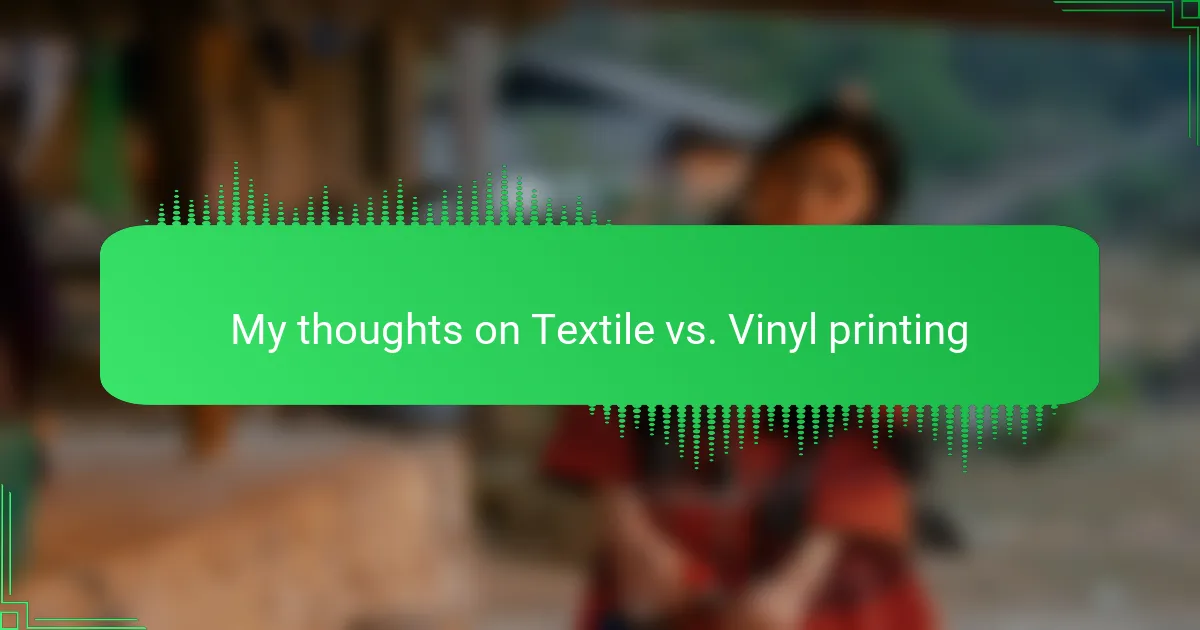Key takeaways
- Textile printing offers a soft feel and excels in capturing intricate designs, making it ideal for artistic and colorful t-shirt designs.
- Vinyl printing is known for its durability and vibrant colors, best suited for bold, simple graphics and logos.
- Choosing the right method depends on the desired outcome: comfort and design detail favor textile printing, while durability and visual impact favor vinyl printing.
- Textile prints remain breathable after multiple washes, whereas vinyl prints can feel heavier and less breathable over time.
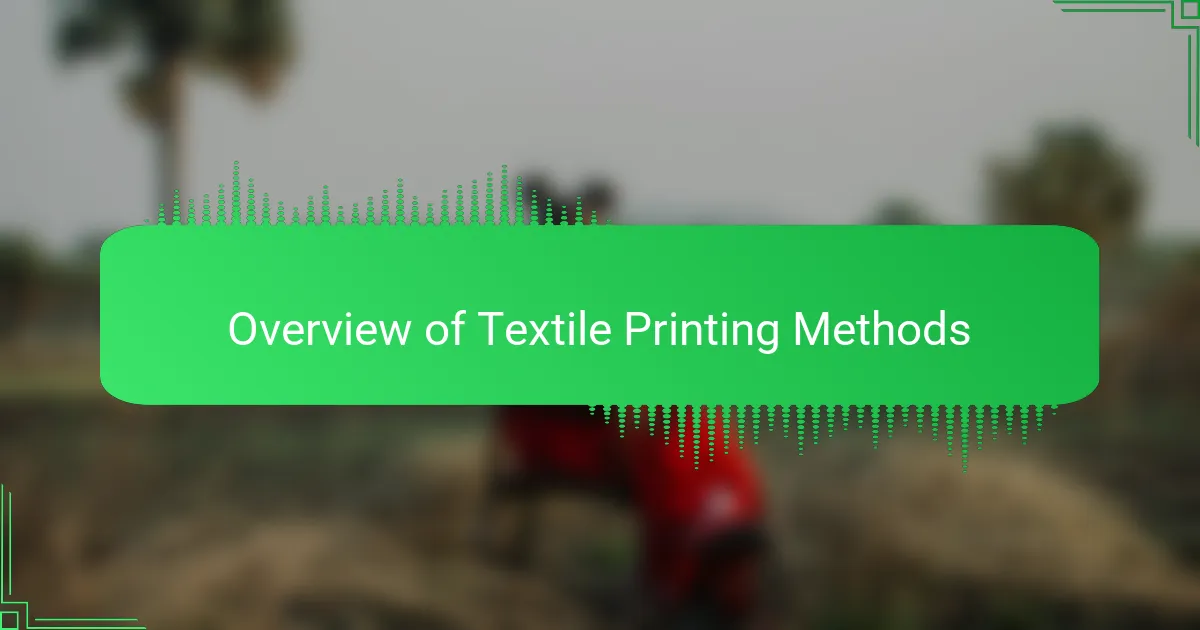
Overview of Textile Printing Methods
When it comes to textile printing, there are several methods to consider. From my experience, each technique offers unique advantages depending on the design complexity and fabric type. I find that understanding the basics helps in making the right choice for a t-shirt project.
Vinyl printing differs notably from traditional textile methods due to its durability and vibrant finish. I’ve noticed that vinyl works best for bold, simple designs, while textile printing shines in capturing intricate details and gradients.
| Printing Method | Pros | Cons |
|---|---|---|
| Screen Printing | Great for bulk orders, vibrant colors, durable | Limited color range per screen, setup time |
| Direct-to-Garment (DTG) | Ideal for detailed, colorful designs; soft feel | Less durable than vinyl, slower for large orders |
| Heat Transfer Vinyl (HTV) | Durable, excellent for bold designs, easy to use | Not suitable for intricate multicolor gradients |
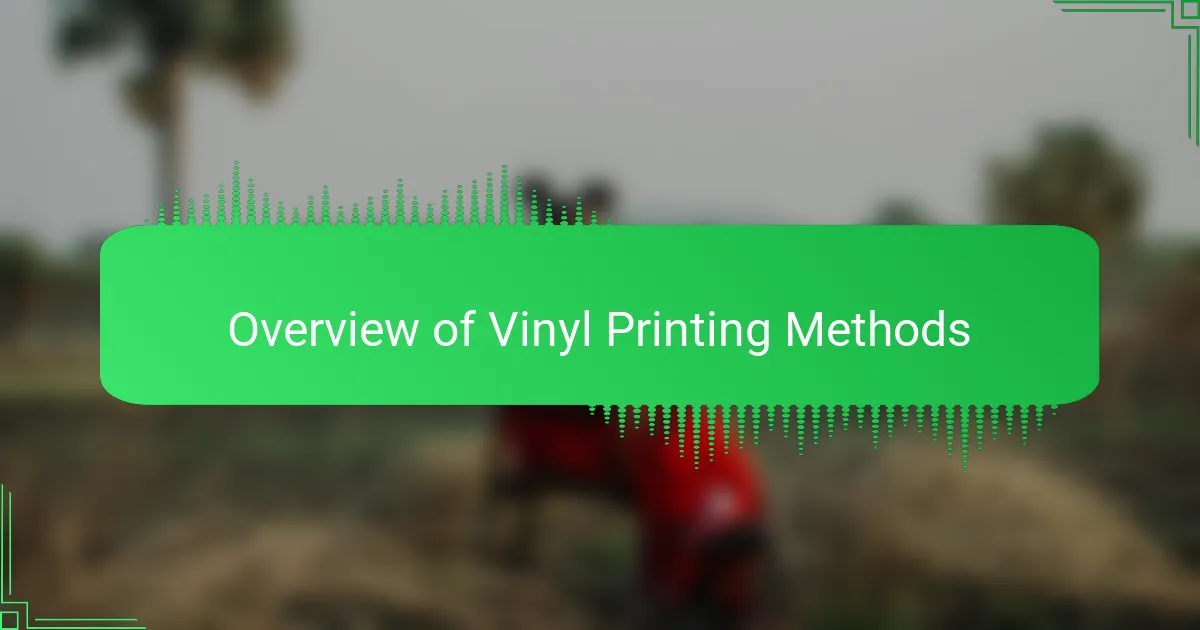
Overview of Vinyl Printing Methods
Vinyl printing is a popular method in t-shirt design for its durability and vibrant finish. From my experience, it’s great when you want sharp, clean graphics that really pop, especially on darker fabrics. The process involves cutting designs from colored vinyl sheets and heat pressing them onto the fabric, creating a slightly raised texture that feels sturdy to the touch.
One thing I’ve noticed is that while vinyl prints are incredibly durable, they can sometimes feel heavier or less breathable compared to textile printing. That said, for bold logos or simple designs, vinyl is a reliable choice that stands out without fading quickly. Here’s a quick comparison to help clarify the main types of vinyl printing methods:
| Method | Key Features |
|---|---|
| Heat Transfer Vinyl (HTV) | Cut vinyl sheets, heat pressed; excellent for single-color or layered designs; durable and vibrant. |
| Printable Vinyl | Vinyl that can be printed on before cutting; good for multi-color or detailed designs; slightly less durable than HTV. |
| Glow-in-the-Dark/Reflective Vinyl | Specialty vinyls that add unique effects; perfect for standout designs but may require special care. |
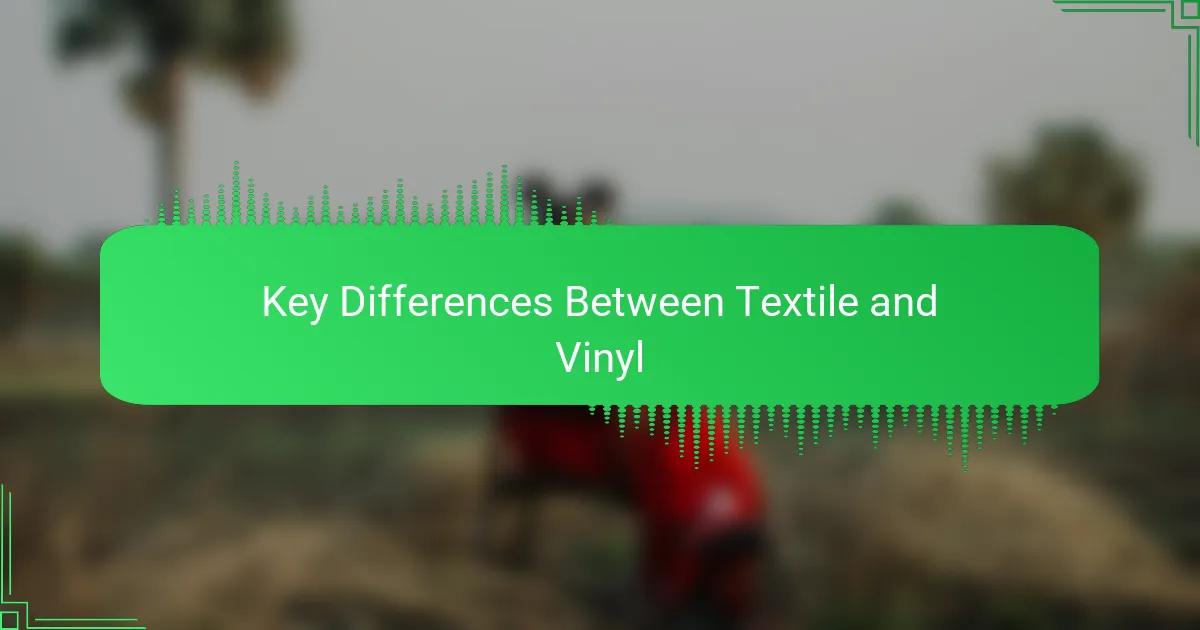
Key Differences Between Textile and Vinyl
Textile and vinyl printing each bring something unique to the table when it comes to t-shirt design. From my experience, textile printing feels more integrated with the fabric, making the design softer to the touch and ideal for intricate artwork. Vinyl, on the other hand, offers bold and vibrant colors that really stand out but can sometimes feel less breathable, which I’ve noticed during long wear.
| Aspect | Textile Printing | Vinyl Printing |
|---|---|---|
| Texture | Soft and fabric-like, blends with the shirt | Thicker, raised texture on the surface |
| Durability | Fades gradually but stays flexible | Very durable but can crack over time |
| Color Vibrancy | Subtle and natural tones | Bright, bold, and highly saturated colors |
| Detail Capability | Great for fine, detailed designs | Best for simple, bold shapes and text |
| Breathability | Highly breathable and comfortable for long wear | Less breathable, can feel heavy in warm conditions |
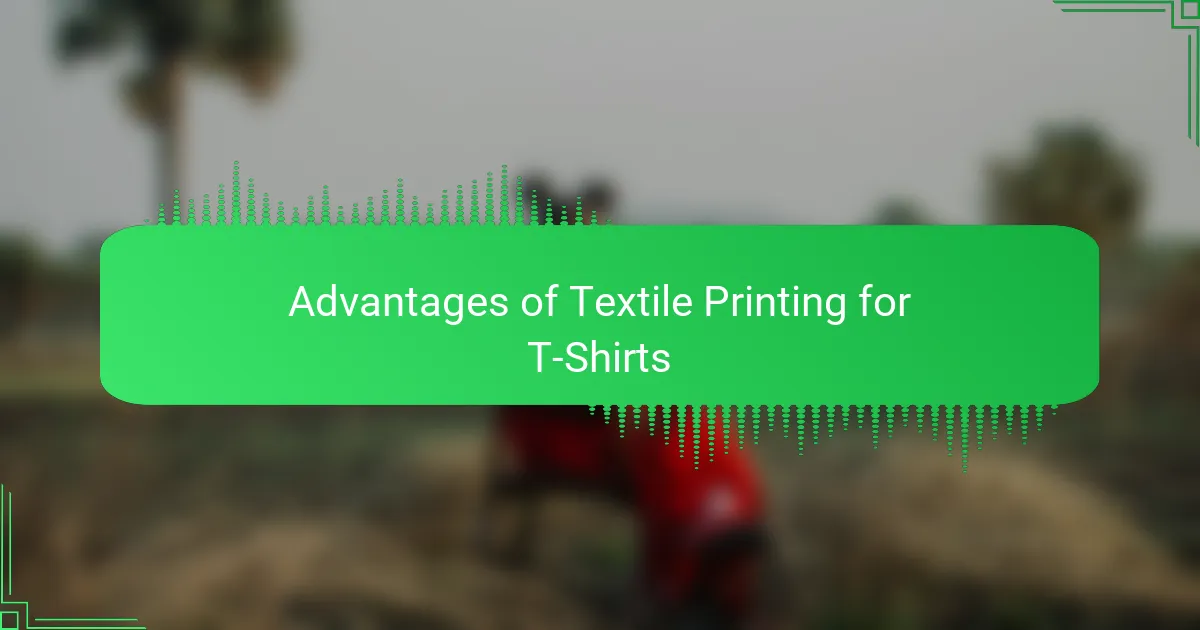
Advantages of Textile Printing for T-Shirts
One thing I truly appreciate about textile printing is how naturally the design blends into the fabric. It never feels like a sticker slapped on; instead, the print becomes part of the t-shirt’s very texture. Have you ever worn a shirt where the design feels soft and almost invisible to the touch? That’s the magic of textile printing, making comfort a priority without sacrificing visual appeal.
From my experience, textile printing also excels when I want to showcase intricate and colorful artwork. Unlike vinyl, it captures fine details and gradients beautifully, which always impresses me when I see a subtle watercolor or a complex pattern come to life on a shirt. It’s like the fabric itself is a canvas, inviting art that breathes and moves with you.
Another advantage I’ve noticed is how breathable textile-printed shirts remain after many washes. Vinyl can sometimes feel heavy or stiff, especially during warmer days. But with textile printing, the shirt stays light and flexible, making it my go-to method for t-shirts meant for all-day wear. Don’t you prefer a design that feels as comfortable as it looks? That’s exactly why I lean towards textile printing for most of my projects.
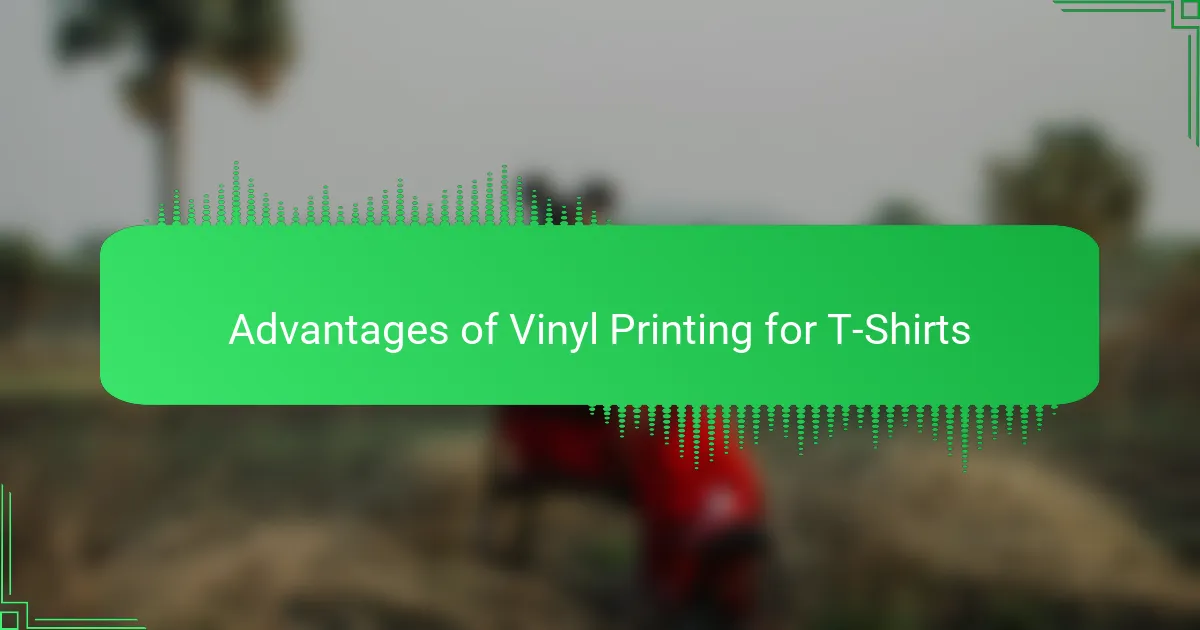
Advantages of Vinyl Printing for T-Shirts
Vinyl printing stands out to me for its durability and vibrant color payoff. From my experience, designs made with vinyl hold up impressively well after many washes, keeping their colors bold and edges sharp. This quality makes vinyl my go-to when I want a long-lasting and eye-catching design that doesn’t fade quickly.
| Feature | Vinyl Printing |
|---|---|
| Durability | Highly durable; resists cracking and fading over time |
| Color Vibrancy | Bright, solid colors that maintain their punch |
| Wash Resistance | Excellent; can withstand many washes without deterioration |
| Texture | Smooth and slightly raised, adding a tactile dimension to designs |
| Best Use Case | Simple, bold graphics and lettering |
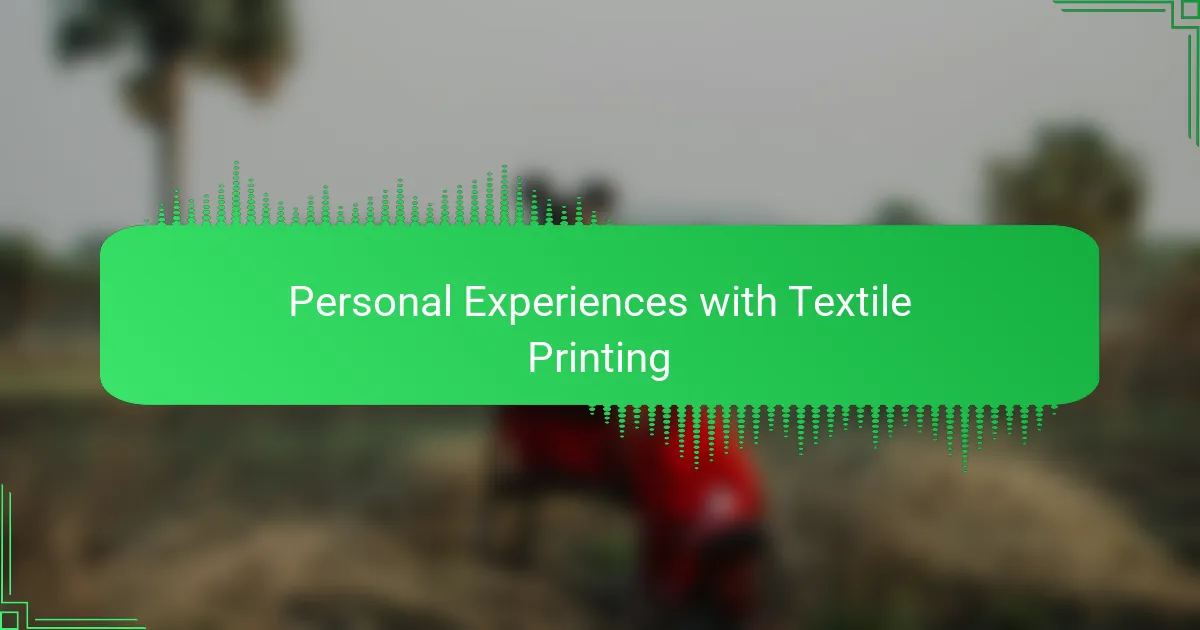
Personal Experiences with Textile Printing
I remember the first time I experimented with screen printing on a cotton tee—it was surprisingly rewarding to see how the ink melded with the fabric, creating a design that felt like part of the shirt itself. Have you ever caught yourself touching a print just to feel that softness? That tactile experience always makes me appreciate textile printing even more.
One thing that struck me early on was how textile printing handled complex artwork. I once printed a detailed floral pattern with delicate shading, and the depth it retained on the shirt amazed me. It really made me realize how this method shines when you want to capture subtle nuances that vinyl can’t quite match.
But it’s not just about looks. After wearing and washing textile-printed shirts multiple times, I found they stayed breathable and comfortable—something I value a lot for daily wear. Isn’t it frustrating when a printed shirt feels heavy or stiff? Textile printing has definitely been my comfort champion in that regard.
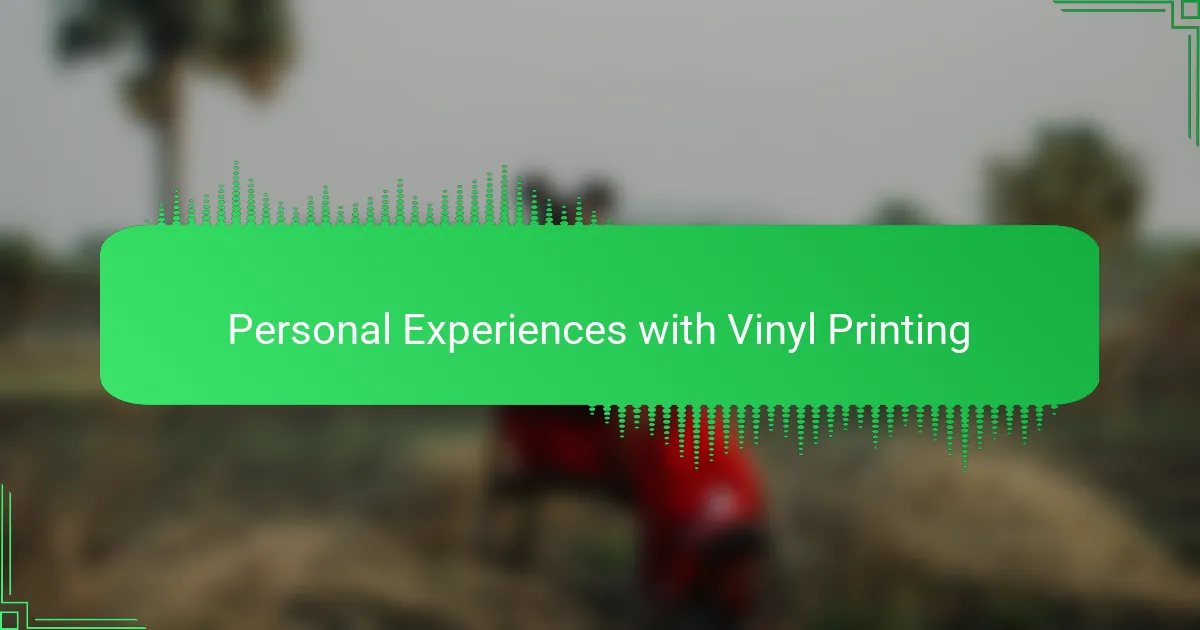
Personal Experiences with Vinyl Printing
I’ve been using vinyl printing for a variety of t-shirt projects, and one thing that always impresses me is how crisp and vibrant the designs come out. There’s something satisfying about peeling away the backing paper after heat pressing and seeing those bold colors pop sharply against the fabric. Have you ever felt that instant wow moment when a design just “clicks” perfectly? That’s exactly the kind of impact vinyl can deliver.
In my experience, vinyl’s durability really shines through over time. I remember gifting a vinyl-printed tee to a friend who’s quite active, and months later, the design still looks fresh with no signs of cracking or fading. I find that this toughness makes vinyl my top choice for apparel meant to withstand rougher wear or frequent washing.
That said, I can’t deny the slightly thicker feel vinyl prints add to a shirt. Sometimes, especially on hot days, I notice the print isn’t as breathable as textile methods, making the shirt feel a bit heavier. But honestly, for bold logos or simple text, I’m willing to trade a little comfort for that standout look. Do you prefer durability over softness? For me, vinyl strikes a great balance when durability is key.
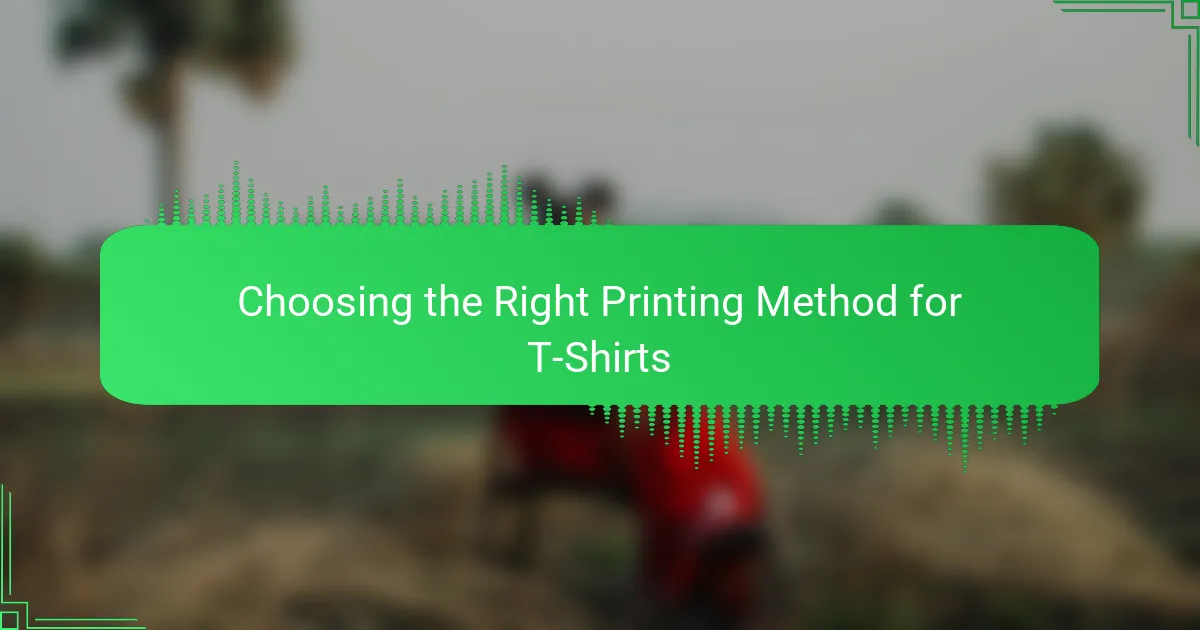
Choosing the Right Printing Method for T-Shirts
Choosing the right printing method for t-shirts often feels like navigating a maze, but I find focusing on the end-use really helps. Textile printing, with its soft feel and vibrant colors, is my go-to when comfort and design depth matter most. Vinyl printing, on the other hand, offers bold, durable graphics that are perfect for simpler designs that need to pop and last.
| Aspect | Textile Printing | Vinyl Printing |
|---|---|---|
| Feel on Fabric | Soft and breathable, blends well with the fabric | Thicker texture, can feel heavier on the shirt |
| Design Complexity | Excellent for detailed, multicolor designs | Best for simpler, bold graphics and text |
| Durability | May fade after many washes | Highly durable and resistant to fading |
| Cost | Generally more cost-effective for large, complex designs | More expensive, especially for multi-layer prints |
| Ideal Use | Casual wear with artistic or photographic prints | Sportswear, team uniforms, and logos |
